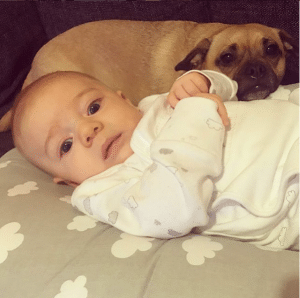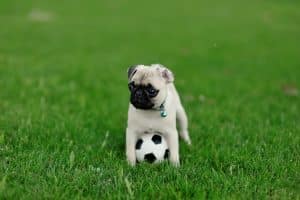You only have to scroll through Instagram for a few minutes to find adorable photos and videos of dogs and babies. But, like with most posts on social media, the reality of letting your dog and baby socialise can be a lot more difficult than it appears and their encounters can sometimes have dangerous consequences if your dog is not trained correctly. We will explore tips for successful and positive play between your dog and baby to help create that special bond safely.
When is it safe to leave a dog with a baby?
The short answer is it’s never safe to leave your baby with your dog. As much as we love and trust our furry friends, you never know when a dog could snap. Anything from baby’s squeals, sudden movements or even smells could be enough to trigger a lively reaction from your pooch. Even if they’re being friendly, unsupervised interaction between your dog and your baby can lead to frightening results in a short space of time due to the unpredictable nature of the animals.
When can my baby play with our dogs?
As you will know, every dog and every baby is different so there is no set age for when your baby and dog can play. If your dog is familiar with babies and young children and they know how to behave appropriately around them then you will naturally introduce them from an early age and encourage their relationship. If your dog has never been around babies or young children then additional training and encouragement may be required to help their relationship.
How to introduce a baby to your dog.

On bringing your baby home you may want to carefully consider their first meeting to help your dog to bond with the baby. Ensure that you make a fuss over your dog in the same way you normally would when you return home. Keep things calm and show the baby to your dog. Never leave your baby alone in the same room as your dog. Your dog may seem disinterested in your baby at first but this could change if baby makes a particular noise or action. You may want to consider baby gates or dog pens to keep the two separate when you leave the room until your baby is older and they are more familiar.
Tips for good dog and baby play
- Always with supervision. The most important element of successful dog and baby interactions is constant supervision. This involves physically being in the room with the two and prepared for potential distractions (phone ringing, someone at the door etc) it’s essential that baby and dog aren’t left alone even for a brief moment.
- Be proactive, not reactive. When supervising the interaction between your dog and baby it ’s essential that you are proactive in preventing unsafe interactions rather than reactive to unwanted situations once they’ve already begun. An example of this is if your baby goes to approach your sleeping dog you should proactively redirect your little one before they disturb your dog rather than react when your baby is already disturbing your sleeping dog.
- Reward positive behaviours. During their supervised interaction, be quick in praising your dog or even rewarding with a treat when your dog is behaving desirably. Let them know playing nicely and being calm around your baby is a good thing.
- Monitor dog licks. We know that dogs’ mouths contain many bacteria but thankfully those germs are unlikely to make your baby sick. Some experts believe that exposure to dogs and their germs can help children to avoid allergies in later life. Even so, especially with young babies whose immune systems are still developing, you will probably want to avoid letting your dog lick them at that age.
- Avoid face to face. Some dogs lick our faces as a sign of affection but it can be seen as a dominant behaviour. You should be wary of letting your dog exhibit dominant behaviour over your baby. Additionally, your dog licking your baby’s face could be seen as maternal behaviour. Again, you should be wary of letting your dog ‘mother’ your baby by licking its face in case it leads to other acts such as nipping (think about how dogs treat their puppies compared to how we treat our babies).
- Talk softly throughout. To maintain a calm atmosphere for dog and baby throughout their interactions, talk softly and positively. Raised voices, sudden commands and even shouting may cause quick reactions from your dog towards your baby or vice versa.
- Stop play if the dog is getting carried away. If your dog begins to get overly excited or their behaviour starts to change in a way that concerns you, stop the playtime to give both dog and baby a break. Equally, if your baby starts to become overwhelmed by the play then removing them from the situation will be best for their relationship in the long term.
- Regular short playtimes. Set up these supervised meetings between your dog and baby regularly to make it normal for them to get along. Keep the playtimes short initially so that both baby and dog can get used to one another. Remember that even after frequent playtimes it’s still essential that they are supervised.
Conclusion
The beautiful bond between dog and baby is possible but will take a lot of dedication to ensure that their relationship is consistently a smooth one. Remembering that as much as we love and trust our dogs, they should never be left alone with our babies because of the naturally unpredictable nature of both. Regular, short and supervised meetings between your dog and baby from a young age are the key to a successful relationship in the future.
Products which you may be interested in

